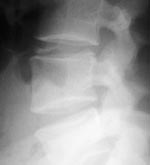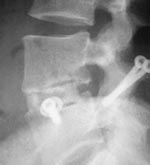Selective retention of cells being tested in spine fusion
The results of a two-year pilot study that will be in this fall look good. Other studies are underway.
There are approximately 200,000 autologous bone grafts harvested from the iliac crest annually for lumbar spinal fusions. With that, there is significant donor-site morbidity and upwards of 30% of patients report chronic hip pain afterwards. And despite a surgeon’s best efforts, fusion rates with autograft can range anywhere from 60% to 90%.
In Summary
|
These stark facts have driven researchers over the last decade to develop alternative bone graft substitutes. Perhaps most well known are the bone morphogenetic proteins, Infuse from Medtronic Sofamor Danek and OP-1 from Stryker Biotech.
This fall, however, a two-year pilot study will be completed for a technology that allows surgeons to concentrate a patient’s stem cells for spinal fusions. Isador Lieberman, MD, of the Cleveland Clinic, is conducting the study, which is the first to use stem cells in a human spine model. He said he is satisfied with the results so far.
“We have 42 levels that we ended up fusing and there was one level that I ended up revising for pseudoarthrosis. Ideally, you want a 100% fusion rate on clinical grounds, but one pseudoarthrosis is not bad,” Lieberman said. He described the radiographic criteria for fusion as “very, very rigorous.” According to preliminary analysis, over 90% of the levels operated on were deemed to be either definitely or probably fused.
Twenty-six patients were enrolled in the study and there will be 20 available for follow-up at two years. Patients underwent either an anterior lumbar interbody fusion with a femoral ring allograft and translaminar screws from behind or a posterior lumbar interbody fusion with pedicle screws from behind.
In place of autograft bone, patients received a graft substitute made by using the Cellect process from DePuy Biotech. The patient’s bone marrow is aspirated from the iliac crest, then filtered through a matrix of mineralized cancellous bone chips and demineralized cortical fibers. The matrix is highly porous and has a high surface area for cell attachment, so more than 90% of the osteogenic stem cells are retained, while most of the red and white blood cells pass through.
Patient’s tissue
| ||
“It’s the patient’s own tissue, so there’s really no inherent issues with respect to rejection or potential infections or all those other issues that can emerge when you use allograft tissue. The other big advantage is the minimal morbidity. You’re putting a needle into the iliac crest, and this does not bother the patient at all.”
Lieberman said that another advantage was the minimal cost of Cellect, especially when compared to the expense of products such as Infuse and OP-1.
In addition to Lieberman’s study, there are several other multicenter spinal fusion studies underway in the United States. They will investigate the use of Cellect for posterolateral fusion, interbody fusion with and without implants and with bone dowels, fusion cages, pedicle screws and femoral rings.
“The great thing about this system is what you’re doing is harvesting the cells and tipping the biologic balance to allow those cells to propagate and form bone,” Lieberman said.


